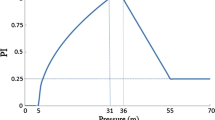Abstract
The purpose of this paper is to evaluate the seismic safety of water supply pipeline networks. It proposes a definition of seismic safety of water supply pipeline networks based on research results regarding seismic damage prediction and functional failure analysis of such networks, referring to the basic concept of safety. The definition proposes restrictive criteria and finality criteria. This paper establishes a division standard for the seismic safety level of a water supply pipeline networks. It establishes a preliminary evaluation method and model of the seismic safety of the water supply pipeline networks in combination with a seismic damage prediction model and functional failure analysis model. It makes it possible to evaluate whether a water supply pipeline networks meets the current seismic specification requirements. This evaluation method can also provide a scientific basis for urban earthquake disaster reduction and reconstruction. Finally, with this method, the water supply pipeline networks seismic safety is evaluated for Harbin and corresponding suggestions are put forward.

Similar content being viewed by others
References
Brozovic, N., Sunding, D.L., Zilberman, D.: Estimating business and residential water supply interruption losses from catastrophic events. Water Res. Res. 43(8), 1–14 (2007)
Nigg, J.: Perceptions of earthquake impacts and loss- reduction policy preferences among community residents and option leaders. Disaster Research Center, University of Delaware, Delaware (1998)
Fournier D’Albe, E.M.: Objectives of volcanic monitoring and prediction. J. Geol. Soc. 136, 321–326 (1979)
International Disaster Risk Management Association. Disaster Risk and Vulnerability. http://www.waterdisaster.org/ibis/wash/eng/Disaster-risk-and-vulnerability(2010). Accessed 19 Sept 2013
United States Agency for International Development. introduction to disaster risk reduction. Washington DC, (2011)
Lv, D., Yu, X., Song, P., et al.: From the wenchuan earthquake reflections on the seismic safety, vulnerability and robustness of structures. In: Conference on Earthquake Engineering and Mitigating Earthquake Disasters Marking the First Anniversary of the Wenchuan Earthquake, Beijing, pp. 276–287 (2009)
Lv, M., Wang, J., Zhang, H.: Comprehensive safety evaluation method for urban water supply networks. J. Hydraul. Eng. 40(12), 1489–1494 (2009)
Wang, Z., Su, J., Wang, W., et al.: Study on safety evaluation methods for water distribution networks based on LS-SVM. China Saf. Sci. J. 20(11), 119–123 (2010)
Wang, W., Hou, B., Tian, J., et al.: Method for assessment of seismic safety of urban water distribution system using stochastic simulation and triangular fuzzy numbers. China Civil Eng. J. 46(2), 278–281 (2013)
Wang, C.: Seismic safety summary of lifeline engineering. Yinshan Acad. J. 30(1), 145–146 (2016)
Shi, P.: Seismic response modeling of water supply system. Cornell University, Ithaca (2006)
Wang, Y., Au, S.K.: Spatial distribution of water supply reliability and critical links of water supply to crucial water consumers under an earthquake. Reliab. Eng. Syst. Saf. 94(2), 534–541 (2009)
Wang, Y., Au, S.K., Fu, Q.: Seismic risk assessment and mitigation of water supply systems. Earthq. Spectra 26(1), 257–274 (2010)
Wu, Y., Xu, Y., Wang, W.: A software tool for reliability, analysis, and security assessment of water distribution systems. In: Proceedings of ICPTT, Wuhan, pp. 48–55 (2012)
UNISDR. Disaster Risk. http://www.unisdr.org/Who-we-are/what-is-drr (2009). Accessed 22 Sept 2013
Hu, Y.: Earthquake Engineering, 2nd edn. Seismological Press, Beijing (2006)
National Standard of the People’s Republic of China. Code for Seismic Design of Outdoor Water Supply Sewerage, Gas and Heating Engineering (GB 50032- 2003), (2003)
National Standard of the People’s Republic of China. Classification of Earthquake Damage to Lifeline Engineering (GB/T24336-2009), (2009)
Hwang, H., Lin, H., Shinozuka, M.: Seismic performance assessment of water delivery system. J. Infra. Sys. ASCE 4(3), 118–125 (1998)
Song, R.: How to prevent the leakage of water supply systems. China Building Industry Press, p. 7 (1988)
Ballantyne, D.B., Berg, E., Kennrdy, J., Reneau, R, Wu, D.: Earthquake loss estimation modeling of the seattle water system. Report of US.Geological Survey, (1990)
Acknowledgements
The financial support from the Scientific Research Program of Seismological Industry with Special Funds No.201508023 and the Program of “12th Five-year Plan” National Science and Technology Support Plan No.2015BAK17B05 are gratefully acknowledged.
Author information
Authors and Affiliations
Corresponding author
Rights and permissions
About this article
Cite this article
Li, Q., Guo, E. & Yu, T. Study on seismic safety evaluation of water supply pipeline networks. Cluster Comput 22 (Suppl 3), 6647–6656 (2019). https://doi.org/10.1007/s10586-018-2397-3
Received:
Revised:
Accepted:
Published:
Issue Date:
DOI: https://doi.org/10.1007/s10586-018-2397-3




